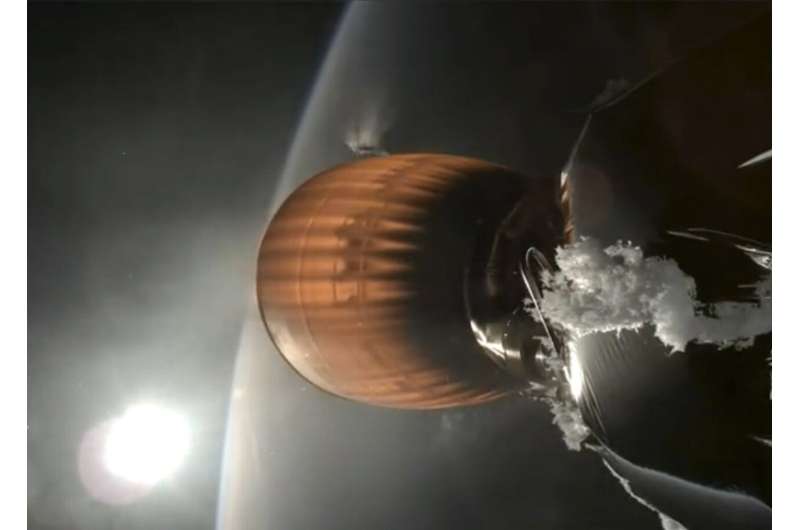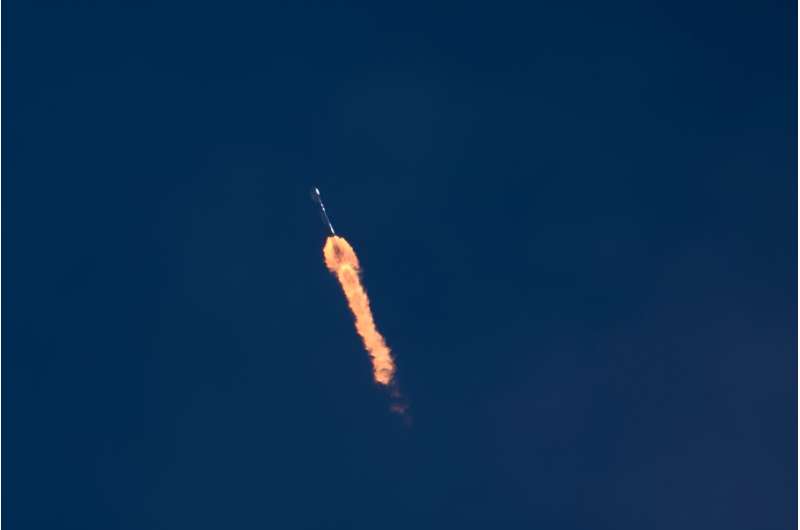SpaceX rocket accident leaves company's Starlink satellites in wrong orbit
Saturday, 13 July 2024 07:29
A SpaceX rocket has failed for the first time in nearly a decade, leaving the company's internet satellites in an orbit so low that they're doomed to fall through the atmosphere and burn up.
SpaceX Falcon 9 rocket experiences rare failure
Friday, 12 July 2024 20:24
SpaceX's highly reliable Falcon 9 rocket has experienced a rare failure that means the latest batch of the company's Starlink satellites won't make it into orbit, the company said Friday, as regulators opened an investigation.
The rocket, a prolific launch vehicle that propels both satellites and astronauts into orbit, blasted off from Vandenberg Space Force Base in California on Thursday night, with the first stage performing well and executing its impressive yet now routine droneship landing.
But the second stage developed a liquid oxygen leak, SpaceX said in a statement, leaving it unable to complete a planned second burn.
Virgin Galactic Unveils New Spaceship Manufacturing Facility in Arizona
Friday, 12 July 2024 17:40 Virgin Galactic Holdings, Inc. (NYSE: SPCE) has announced the completion of a new manufacturing facility in Phoenix, Arizona. This facility will handle the final assembly of the Company's next-generation Delta spaceships, with production slated to start in Q1 2025.
The initial team, comprising Virgin Galactic's technical operations and manufacturing personnel, is currently preparing the fa
Virgin Galactic Holdings, Inc. (NYSE: SPCE) has announced the completion of a new manufacturing facility in Phoenix, Arizona. This facility will handle the final assembly of the Company's next-generation Delta spaceships, with production slated to start in Q1 2025.
The initial team, comprising Virgin Galactic's technical operations and manufacturing personnel, is currently preparing the fa Leidos secures $476M NASA contract for ISS and Artemis Cargo Support
Friday, 12 July 2024 17:40 Leidos (NYSE: LDOS) has been awarded a significant contract to continue providing cargo mission engineering and integration services for NASA's International Space Station (ISS) Program and Artemis campaign. The contract, which holds a total potential value of $476 million, includes a base performance period of two years. The primary work will be conducted at Leidos' facilities in Webster, Texas
Leidos (NYSE: LDOS) has been awarded a significant contract to continue providing cargo mission engineering and integration services for NASA's International Space Station (ISS) Program and Artemis campaign. The contract, which holds a total potential value of $476 million, includes a base performance period of two years. The primary work will be conducted at Leidos' facilities in Webster, Texas i-Space Rocket Test Faces Setback with SQX-1 Y8 Launch
Friday, 12 July 2024 17:40 The recent test flight of the SQX-1 Y8, a commercial carrier rocket developed by the Chinese private aerospace firm i-Space, ended in failure on Thursday.
The rocket launched from the Jiuquan Satellite Launch Center in northwest China at 7:40 am Beijing Time. Shortly after liftoff, the SQX-1 Y8 exhibited abnormal performance, leading to an unsuccessful mission.
The SQX-1, also known
The recent test flight of the SQX-1 Y8, a commercial carrier rocket developed by the Chinese private aerospace firm i-Space, ended in failure on Thursday.
The rocket launched from the Jiuquan Satellite Launch Center in northwest China at 7:40 am Beijing Time. Shortly after liftoff, the SQX-1 Y8 exhibited abnormal performance, leading to an unsuccessful mission.
The SQX-1, also known Hera's Propulsion System Passes Critical Leak Test
Friday, 12 July 2024 17:40 ESA's Hera asteroid mission, designed for planetary defense, has successfully undergone a crucial phase in its test campaign by being placed back in its transport container.
The spacecraft will remain at the ESTEC Test Centre in Noordwijk, the Netherlands, until the end of August. During this period, Hera's container was used for a global leak test to confirm the integrity of its propulsio
ESA's Hera asteroid mission, designed for planetary defense, has successfully undergone a crucial phase in its test campaign by being placed back in its transport container.
The spacecraft will remain at the ESTEC Test Centre in Noordwijk, the Netherlands, until the end of August. During this period, Hera's container was used for a global leak test to confirm the integrity of its propulsio China's Tianwen 2 Mission Targets Asteroid and Comet Exploration
Friday, 12 July 2024 17:40
 China's Tianwen 2 probe is set to launch aboard a Long March 3B rocket in May 2025. This mission aims to collect samples from a near-Earth asteroid and deliver them to Earth, followed by a journey to study a comet in deep space.
The probe's first target is the near-Earth asteroid 469219, known as Kamo'oalewa in Hawaiian. After reaching the asteroid, Tianwen 2 will perform remote sensing
China's Tianwen 2 probe is set to launch aboard a Long March 3B rocket in May 2025. This mission aims to collect samples from a near-Earth asteroid and deliver them to Earth, followed by a journey to study a comet in deep space.
The probe's first target is the near-Earth asteroid 469219, known as Kamo'oalewa in Hawaiian. After reaching the asteroid, Tianwen 2 will perform remote sensing
NASA Evaluates Electrical Components for Europa Clipper Mission
Friday, 12 July 2024 17:40 Launch preparations for NASA's Europa Clipper mission are moving forward. The spacecraft, which arrived at NASA's Kennedy Space Center in Florida in May, recently had its high-gain antenna installed.
"Engineers with NASA's Europa Clipper mission continue to conduct extensive testing of transistors that help control the flow of electricity on the spacecraft." This follows concerns that thes
Launch preparations for NASA's Europa Clipper mission are moving forward. The spacecraft, which arrived at NASA's Kennedy Space Center in Florida in May, recently had its high-gain antenna installed.
"Engineers with NASA's Europa Clipper mission continue to conduct extensive testing of transistors that help control the flow of electricity on the spacecraft." This follows concerns that thes Building a Digital Preview of the Universe
Friday, 12 July 2024 17:40 Imagine gazing into the night sky and observing millions of galaxies spanning a vast expanse of space. Consider the thrill of searching for exoplanets or witnessing the explosive deaths of stars.
In the upcoming years, two U.S.-funded telescopes will make these observations possible. Ahead of their operational debut, a Duke researcher is spearheading an initiative under the OpenUniverse pr
Imagine gazing into the night sky and observing millions of galaxies spanning a vast expanse of space. Consider the thrill of searching for exoplanets or witnessing the explosive deaths of stars.
In the upcoming years, two U.S.-funded telescopes will make these observations possible. Ahead of their operational debut, a Duke researcher is spearheading an initiative under the OpenUniverse pr New Proposal Redefines Planetary Criteria Beyond Our Solar System
Friday, 12 July 2024 17:40 Planetary scientists are suggesting an updated definition of a planet to replace the current, sun-centric one deemed outdated by many researchers. Established in 2006 by the International Astronomical Union (IAU), the existing definition states that a celestial body must orbit the sun within our solar system to be classified as a planet.
However, scientists recognize the prevalence of cele
Planetary scientists are suggesting an updated definition of a planet to replace the current, sun-centric one deemed outdated by many researchers. Established in 2006 by the International Astronomical Union (IAU), the existing definition states that a celestial body must orbit the sun within our solar system to be classified as a planet.
However, scientists recognize the prevalence of cele Galactic 'Heart and Lungs' Mechanism Regulates Growth
Friday, 12 July 2024 17:40 A recent study published in the Monthly Notices of the Royal Astronomical Society proposes that galaxies possess a "heart and lungs" mechanism that regulates their growth and prevents them from becoming overly large. This finding sheds light on why galaxies are not as massive as previously anticipated.
The research, conducted by astrophysicists at the University of Kent, suggests that gala
A recent study published in the Monthly Notices of the Royal Astronomical Society proposes that galaxies possess a "heart and lungs" mechanism that regulates their growth and prevents them from becoming overly large. This finding sheds light on why galaxies are not as massive as previously anticipated.
The research, conducted by astrophysicists at the University of Kent, suggests that gala Astronomical Satellite Observes Multiple Gamma-Ray Bursts
Friday, 12 July 2024 17:40 A state-of-the-art astronomical satellite, developed through a collaboration between China and France, has successfully detected three gamma-ray bursts, the Chinese Academy of Sciences announced.
The Space Variable Objects Monitor (SVOM) detected a gamma-ray burst on the morning of June 27, shortly after its Gamma-ray Burst Monitor was activated for testing. The satellite also observed two
A state-of-the-art astronomical satellite, developed through a collaboration between China and France, has successfully detected three gamma-ray bursts, the Chinese Academy of Sciences announced.
The Space Variable Objects Monitor (SVOM) detected a gamma-ray burst on the morning of June 27, shortly after its Gamma-ray Burst Monitor was activated for testing. The satellite also observed two Booz Allen Invests in Quindar to Enhance Satellite Automation
Friday, 12 July 2024 17:40 Booz Allen Hamilton (NYSE: BAH) reports that its corporate venture capital arm, Booz Allen Ventures, LLC, has made a strategic investment in Quindar, a commercial space technology startup focused on automating satellite operations. This investment supports Booz Allen's VoLT business strategy-emphasizing velocity, leadership, and technology-and underscores the importance of integrating advanced t
Booz Allen Hamilton (NYSE: BAH) reports that its corporate venture capital arm, Booz Allen Ventures, LLC, has made a strategic investment in Quindar, a commercial space technology startup focused on automating satellite operations. This investment supports Booz Allen's VoLT business strategy-emphasizing velocity, leadership, and technology-and underscores the importance of integrating advanced t International Law Crucial in Preventing Space Militarization
Friday, 12 July 2024 17:40 A recent study emphasizes the urgent need for countries and international organizations to leverage existing international law to address rising concerns about the militarization of outer space.
The militarization of space is escalating, with the potential to become a battleground. Nations are testing anti-satellite (ASAT) weapons, and satellites could become significant targets during con
A recent study emphasizes the urgent need for countries and international organizations to leverage existing international law to address rising concerns about the militarization of outer space.
The militarization of space is escalating, with the potential to become a battleground. Nations are testing anti-satellite (ASAT) weapons, and satellites could become significant targets during con 


